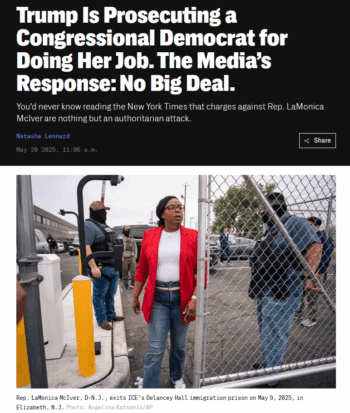
Natasha Lennard (Intercept (5/20/25): “News organizations should…have long ago stopped affording the Trump administration such credulous coverage.”
A FAIR post (5/22/25) on New York Times publisher A.G. Sulzberger’s selective defense of press freedom (New York Times, 5/13/25) referred to him as someone who “clings to the false god of journalistic neutrality at all costs.” Natasha Lennard’s piece in the Intercept (5/20/25) on media coverage of the Trump administration’s arrest of Rep. LaMonica McIver (D–N.J.) illustrates what we mean by this.
McIver, Lennard wrote, was charged with “assaulting” an ICE officer when she “attempted to conduct an oversight visit earlier this month at a massive, new ICE detention facility in her hometown of Newark, New Jersey.” Such oversight is part of representatives’ constitutional duty, and is specifically authorized by law in the case of ICE facilities. Lennard noted that if this had happened in a different country—one not favored by Washington—this would have been reported, accurately enough, as something like, “Regime targets opposition politician with fabricated charges for carrying out oversight.”
But as it happened in the United States, that’s not how leading US news outlets—including the New York Times (5/19/25)—reported it. “Rep. McIver Charged With Assault Over Clash Outside Newark ICE Center” was the Times headline over an article that followed the Times‘ he said/she said stylebook. “Both sides have pointed to videos from the chaotic scuffle…to accuse each other of instigating the altercation.”
As the Intercept‘s subhead remarked, “You’d never know reading the New York Times that charges against Rep. LaMonica McIver are nothing but an authoritarian attack.” The Times article did not provide the context that ICE has been seizing immigrants without due process and shipping them to foreign prisons in violation of court orders—background that is critical to judging whether the prosecution of a lawmaker that attempted to investigate the agency is in good faith.

“Clash” is a useful word if you want to make an unarmed legislator sound like an evenly matched adversary for Homeland Security commandos (New York Times, 5/19/25).
In his essay, Sulzberger warned that without press freedom, people might not know when their rights are being taken away, or democratic structures undermined:
Without a free press, how will people know if their government is acting legally and in their interest? How will people know if their leaders are telling the truth? How will people know if their institutions are acting to the benefit of society? How will people know if their freedoms are being sustained, defended and championed—or eroded by forces that seek to replace truth and reality with propaganda and misinformation?
But if you follow the Times‘ approach to journalism, in which you must never say that something is happening if someone in power claims it is not happening, then your audience won’t know when their government is acting illegally, or denying truth and reality. (“You can’t just say the president is lying,” Times reporter Elisabeth Bumiller told a DC panel—Extra!, 1–2/05—expressing an actual rule that was enforced even on the paper’s opinion columnists.)
Journalists inevitably, inescapably, have values, and those values necessarily affect what they communicate to their audiences. If they value democracy, then they communicate to their audience that arrests of opposition lawmakers are dangerous. If, on the other hand, they value the appearance of neutrality above all else, then the message readers will get is: Who’s to say?
ACTION ALERT: You can send a message to the New York Times at letters@nytimes.com or via Bluesky: @NYTimes.com. Please remember that respectful communication is the most effective. Feel free to leave a copy of your message in the comments thread here.
This content originally appeared on FAIR and was authored by Jim Naureckas.